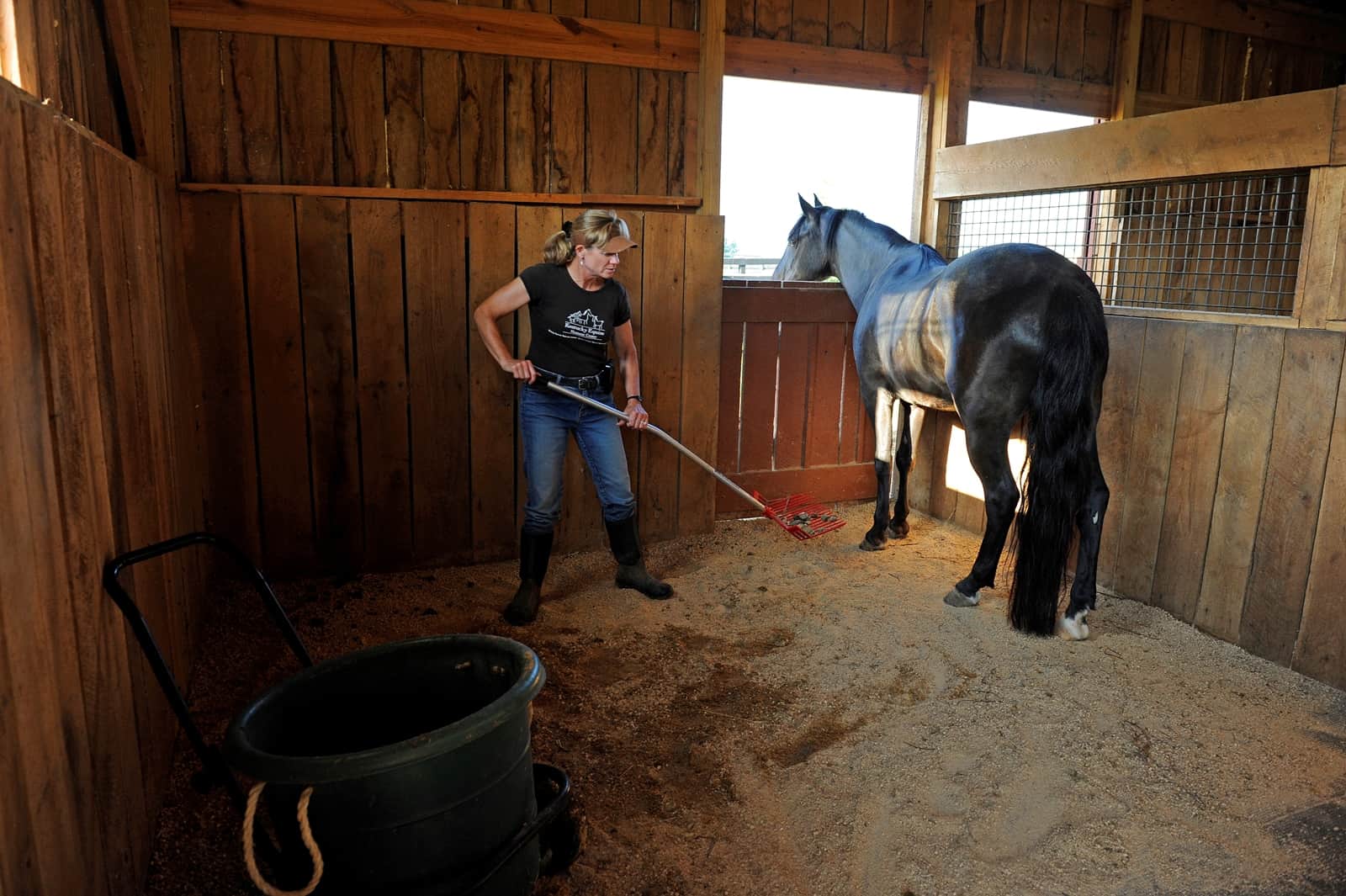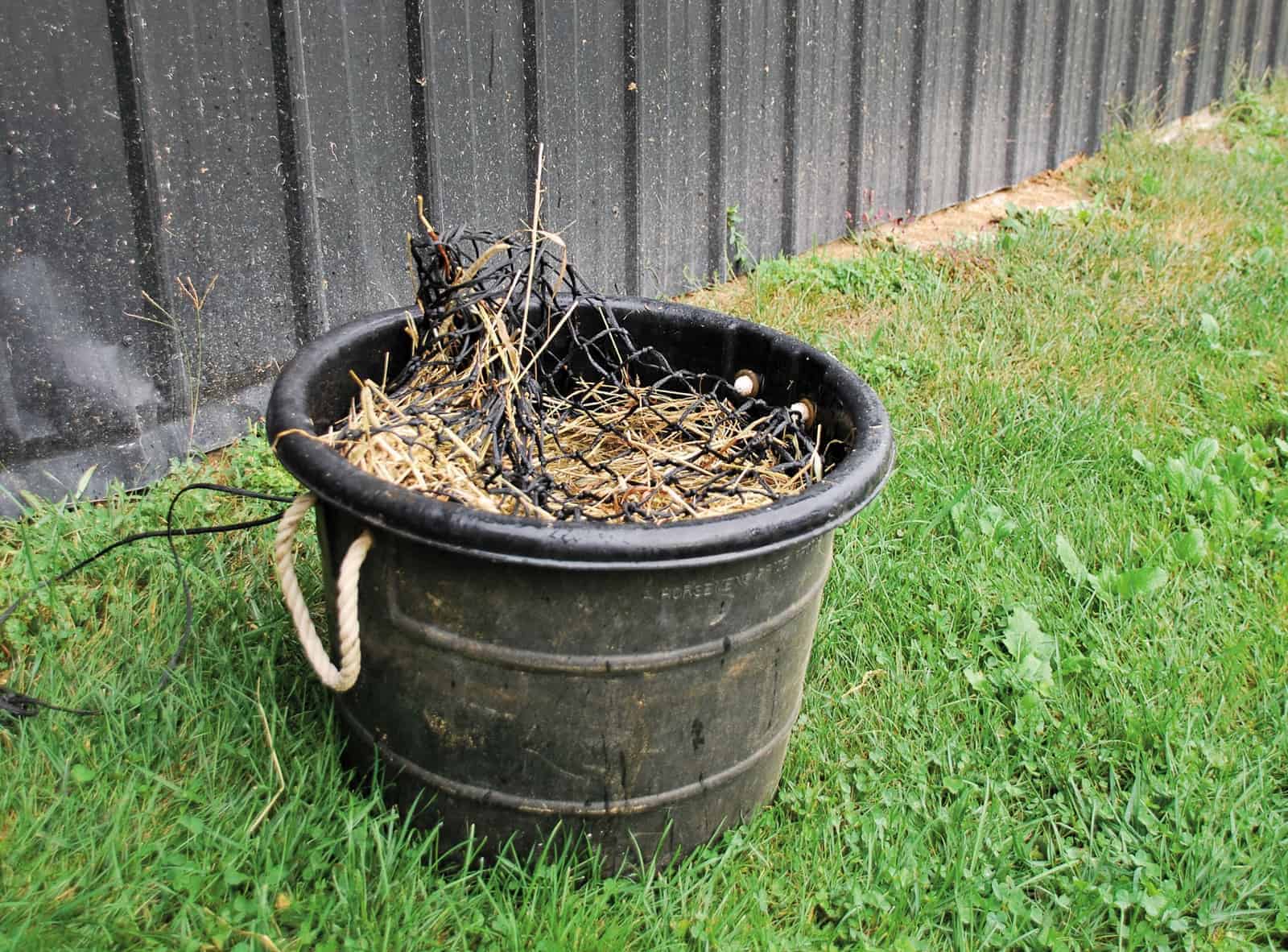Creating an Equine Airway-Friendly Environment

Steps you can take to reduce the number of asthma-causing airborne particulates in your horse’s barn
The next time you walk into your barn on a bright, gorgeous day and look across the aisleway toward the door, note what you see. “When you go into the barn on a sunny day and you see that beautiful beam of light, you should say to yourself, ‘I shouldn’t be able to see light!’ ” says Melissa Mazan, DVM, Dipl. ACVIM, professor of large animal medicine and director of Tufts University’s Equine Respiratory Health Laboratory, in North Grafton, Massachusetts. “You can see it because of particulates in the air.”
She says those airborne particles are the No. 1 cause of equine asthma, and the particulates with the worst effect are those containing endotoxins (which bacterial cells release as they disintegrate) and beta-glucans (which form a part of the structure of common molds).
“Anybody with a background in biology may think that when we refer to endotoxin, we’re referring to infective bacteria, but we’re not actually talking about an infection at all,” says Mazan. “We’re talking about little portions, especially of Gram-negative bacteria, that end up in the environment. It’s in manure, all types of grain and pelleted feeds, in hay, in shavings—it’s everywhere. And beta-glucans are anywhere there’s hay and where there’s mold of any kind. Again, we’re not talking about fungal infection; we’re talking about the bits and pieces of the structure of mold that are highly inflammatory in the respiratory system—both in horses and humans.
“We think of asthma in people as being an allergic disease (involving an immune-system response to irritants), but actually there’s an enormous component of human asthma that’s far more like what we think the majority of horses are getting, which is ‘occupational asthma,’ ” she adds. This can involve irritation from inhaling particulates and toxins in the air.

Julia Montgomery, DVM, PhD, Dipl. ACVIM, associate professor of large animal clinical sciences at the University of Saskatchewan’s Western College of Veterinary Medicine, concurs. “When it comes to asthma, managing the environment is the most important thing; drugs alone will never fix it,” she says. “If you don’t address air quality, nothing else will work long-term.”
To that end, she and her colleagues work with each client who owns a horse with asthma in three areas: What is environmental; what is appropriate; and what is feasible. She advises keeping a journal to pinpoint a horse’s triggers, then addressing those areas. For example, if a dusty arena heightens a horse’s asthma, clients can address that at home. But if they travel to shows, she might talk to them about options for when they’re away.
Asthma’s Effect on Performance
So how does equine asthma affect your horse’s performance? That depends on his competition level and type of asthma.
Regarding performance level, Mazan considers how much of the horse’s respiratory reserve his job requires. “A racehorse needs every last little bit of its respiratory reserve,” she says. “All horses that gallop become markedly hypoxemic (low on blood oxygen), and their CO2 level rises. But racehorses live on the razor edge of sustainability. They suck up every last bit of oxygen when they’re galloping.”

In those horses, she says, you’re going to notice equine asthma before you hear a cough or see nasal discharge. Usually, they’ll be a bit slower than previously. And in a racehorse, just 1/100th of a second can mean the difference between winning and placing several horses back.
“You’ll also see that they have more trouble paying back their oxygen debt when they stop working—they may run well but not recover well,” she adds.
What about horses at a performance level that’s a step down from racing—high-level show jumpers, for example, that aren’t pushed until they’re a bit older and train longer and slower? “When they’re 6, 7, or 8 years old, they won’t have quite the brilliance they once had, or there might be an intermittent cough or clear or mucoid nasal discharge,” says Mazan.
Stepping down another notch, she says the moderate-level dressage horse might have had a little bit of a cough and nasal discharge and suddenly around age 10 has become what she calls a respiratory cripple: He can’t move; he’s breathing hard. “We don’t know what triggers the horse that has had moderate equine asthma to become this horse with the typical, old-fashioned term ‘heaves,’ which most accurately describes it: They stand there with their sides heaving, and they work extraordinarily hard to breathe.”
The type of asthma your horse has also affects his performance, says Montgomery. “There are two forms—mild or moderate and severe. Severe presents with clinical signs at rest: abdominal movement and coughing. Mild to moderate asthma doesn’t display many clinical signs at rest, but the horse will cough during exercise and perform poorly.
“The most commonly ignored sign is coughing,” she adds. “Don’t ignore your horse’s routine coughing; there may be more to it.”
Evaluate Your Barn’s Air Quality
To determine where to start with remedial efforts, you can hire an environmental engineer to measure your barn’s air quality, or you can work with your veterinarian or researchers at a veterinary school to determine areas for improvement.
In a study Mazan was involved with about 10 years ago, the investigators found that 10 hours of barn exposure could increase human and horse risk for respiratory disease symptoms by nine to 10 times above baseline.
While you won’t be able to completely rid your horse of asthma by improving air quality, you can help him live more comfortably and perform better. “If you have a horse that was going to develop severe equine asthma, we think you can stave that off by managing your barn’s air quality,” Mazan says. “If your horse already has the disease, you can improve the disease. The single best thing you can do for a horse with equine asthma is improve the environmental quality, and the most important place is in the stable.”
You certainly can’t go around with a finely woven net trying to capture all the particles you see in that sunny ray of light by the barn door, but you can take steps to reduce the number of particulates to which your horse is exposed.

Improved Ventilation
1. Keep your horses outdoors as much as possible. “As long as they have a three-sided shed to get in out of the wind and rain, they’re usually much happier outside,” Mazan says.
She relates an example of a client in a very cold area of Maine who had grand-prix-level horses with a genetic predisposition to early onset asthma. The only way the client could keep her horses healthy was to keep them turned out 24 hours a day and use rubber mats without bedding when she did bring them into their stalls.
2. If your horse has to be in a barn, Montgomery says you can still improve his ventilation access by locating him closer to an exit and further from the arena and removing him from areas being swept or blown.
“If you work full-time, you can’t always be there to move or monitor the horse, but you can talk with your vet about how to work with caretakers to find doable solutions,” she says.
3. Concentrate on moving air through the barn more than you worry about keeping the barn warm. “The best way to maximize ventilation is to hire a trained barn architect,” Mazan says. They can make sure your eaves and other top-of-structure ventilation sources act as a chimney—not for heat but for air release at the top of the barn—and are designed for maximum ventilation that doesn’t necessarily make the barn colder.
4. Sometimes indoors may be better. “If the air quality outdoors is poor but beyond your control—for instance, from smoke during fire season or dust from gravel or dirt roads—horses might be better off indoors,” Montgomery says. And, she adds, horses with summer- pasture-associated asthma (these animals react to outdoor allergens present in pasture) may be better off in a barn.

Barn Management
1. Move horses outdoors before you use equipment that will increase air particulates (blowers, tractors, etc.) and before dusting or removing cobwebs.
2. Sprinkle the aisle with water or humectants (substances used to retain moisture) before sweeping.
Bedding
1. Straw is bad bedding for horses with equine asthma. Mazan confesses that she still uses straw when bedding foaling mares because shavings get all over the foals, but good, clean wood shavings tend to be better. “Sawdust tends to be very dusty, as well, but the pelleted beddings and shredded paper are really good, even though they don’t conform to our romantic visions of what a stable should look like,” she says.
2. Reduce ammonia levels by using the most absorbent bedding possible, cleaning stalls diligently, and perhaps using an ammonia-eliminating stall product. “High ammonia levels irritate airways in both humans and animals,” Montgomery says.

Feeding
1. If possible, feed hay and grain outdoors so the wind can carry particulates away.
2. Move your horse out of his stall if you have to throw hay down from a loft. “Throwing or plumping up hay can leave particulates in the air for hours,” says Mazan.
3. Avoid hay dispensers that horses tend to bury their noses in, inhaling particulates in the process—these include some types of hanging haynets, upright hay mows, and large round Instead, Mazan says, soak or steam hay to help eliminate airway irritants and keep particulates from becoming airborne.
Montgomery adds that round bales are also more likely to spoil toward the center and harbor mold. If you must use round bales, she says, take them apart with a fork to inspect them before feeding. Also, placing large, slow- feeding haynets around such bales prevents horses from tunneling.
4. Haylage—cuttings wrapped in plastic soon after harvesting to maintain nutrients and moisture—is great if it comes from a reliable “Poorly made haylage can harbor (the toxin that causes the neurologic disease) botulism,” Mazan says.
5. Storing hay in another building is smart for not only decreasing particulates but also preventing barn fires.
6. Feed cubes or complete or pelleted feeds instead of hay, “but be vigilant about enriching your horse’s environment,” Mazan “When you feed complete or pelleted feeds, horses tend to finish their food very quickly. That leads to developing behavioral problems; slow feeders and haynets can help.”
Medical Intervention
1. Corticosteroids decrease airway inflammation and can be administered by mouth, injection, or inhalation using a They’re usually administered for two to four weeks, depending on the severity of a horse’s signs.
“There are many adverse side effects associated with using systemic corticosteroids rather than inhaled, but inhaled corticosteroids can be prohibitively expensive,” says Mazan. “You will need to work with your veterinarian to determine the most effective and safest treatment plan.”
If your horse competes, cautions Montgomery, you’ll need to discuss regulatory considerations and withdrawal periods with your veterinarian.
2. Bronchodilators open up airways when breathing becomes difficult. They’re administered orally or via a nebulizer or metered-dose inhaler as needed.
3. Polyunsaturated omega-3 fatty acids help control inflammation on a supplementary basis. “I wouldn’t recommend this as a primary treatment, but it can help in some horses as an ancillary treatment,” says Mazan.
After decades of research, Mazan says, our ability to treat equine asthma pharmacologically hasn’t improved much. “Right now, we’re doing a study looking at the use of inhaled lidocaine as an anti-inflammatory for use in horses,” she says. “The results are quite promising, but the big guns are still steroids and inhaled bronchodilators.”
Take-Home Message
Each horse is an individual for which treatment must be custom-tailored for optimum results. The pharmaceutical treatments available for equine asthma can’t help your horse unless you first control environmental factors. Implement these suggestions, then work with your vet to monitor your horse’s respiratory status and adjust interventions accordingly.
Written by:
Diane E. Rice
Related Articles
Stay on top of the most recent Horse Health news with












